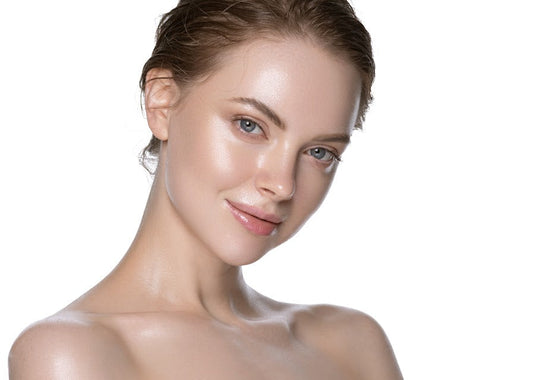
Post-Inflammatory Hyperpigmentation: Triggers and Treatment
Written by Dr Shamsa Kanwal - Dermatologist
Updated on December 24, 2024
Have you ever noticed dark spots left behind after a skin inflammation, injury, bug bite, or skin irritation? This discoloration is known as post-inflammatory hyperpigmentation and is more common and severe in dark-skinned individuals. While the condition usually improves immediately, this process can take months to years, requiring prolonged treatment.
There are many effective ways to get rid of these spots without reaching out for harsh ingredients. In this article, we’ll guide you through details about post-inflammatory hyperpigmentation, including what triggers it, why it sticks around, and how to restore an even, radiant complexion using gentle, skin-friendly solutions.

What Is Post-Inflammatory Hyperpigmentation?
Post-inflammatory hyperpigmentation is a very common skin issue that occurs when your skin produces too much melanin (the pigment responsible for skin color) after an inflammatory event. The inflammation signals your skin to defend itself, leading to pigment production as a protective mechanism. This extra melanin then forms dark spots or patches on your skin [1].
Post-inflammatory hyperpigmentation can affect anyone but mostly affects people with darker skin tones. This is because people of color have naturally more active melanocytes (melanin-producing cells), which can respond more intensely to cutaneous injury [2].
What Causes Post-Inflammatory Hyperpigmentation?
Post-inflammatory hyperpigmentation is more common after acne because breakouts often create inflammation deep within our skin. As a response to the inflammation, our body triggers melanogenesis, the process of melanin production. Even minor pimples or blemishes can leave pigmentation if we keep picking on pimples. It is therefore recommended to avoid touching or squeezing acne to reduce the risk of post-inflammatory hyperpigmentation.
Excessive exposure to UV light also increases melanin production, which can deteriorate existing pigmentation [3]. This is why it is recommended to apply sunscreen when going out in the sun and to reapply it every two to three hours.
Lastly, conditions like lichen planus, psoriasis, and many dermatoses lead to repetitive cycles of inflammation and healing, and our body starts producing extra melanin as a defense system [4]. This makes them common triggers for post-inflammatory hyperpigmentation.
Is Post-Inflammatory Hyperpigmentation Permanent?
Mostly post-inflammatory hyperpigmentation is not permanent, and if we take proper care of it, it will fade over time. However, it can take some time before leaving you with clear skin. The duration of healing largely depends on several factors, including skin type, depth of pigmentation, nature of the trigger (such as acne, injury, or sun exposure), and level of protection and care the skin receives during the healing process.
How Long Does It Take For Post-Inflammatory Hyperpigmentation To Go Away?
Post-inflammatory hyperpigmentation can take anywhere from a few months to several years to fade. Typically, with proper skincare, results may begin to show within 3 to 6 months. The following factors will influence how long it takes for hyperpigmentation to fade:
- Skin Type: Darker skin tones with more active melanocytes may experience long-lasting pigmentation due to increased melanin response.
- Severity of Initial Trauma: The depth and intensity of the initial skin injury or inflammation can influence the pigmentation’s resilience and healing time.
- Ongoing Trauma or Irritation: Repeated irritation or inflammation (such as picking at skin) can prolong or worsen hyperpigmentation.
How to Get Rid of Post-Inflammatory Hyperpigmentation - Conventional Treatment Methods
Traditionally, the following two methods have been widely used for post-inflammatory hyperpigmentation treatment:
- Intense Pulse Light Therapy (IPL): IPL uses multiple wavelengths of light to target pigmentation in our skin, making it effective for lightening dark spots [6]. However, IPL can cause uneven results if you have darker skin, as it may lead to new pigmentation issues if not performed carefully. Therefore, it is recommended to get IPL therapy from a qualified healthcare provider.
- Chemical Peels: Chemical peels can help fade post-inflammatory hyperpigmentation by removing dead skin cells and encouraging new cell turnover. Gentle chemical peels with ingredients like mandelic, and azelaic acid can help lighten dark spots for sensitive skin types. Individuals with acne-prone or sensitive skin should avoid stronger acids like glycolic or lactic acid. However, for deeper peels or more intense treatments, it’s essential to consult a qualified professional to ensure safety and achieve good results [7].
How to Get Rid of Post-Inflammatory Hyperpigmentation with Gentle, Non-Irritating Ingredients
Opting for gentle, non-irritating ingredients is an effective approach to treat post-inflammatory hyperpigmentation without causing additional stress to the skin. Here are a few safe and long-term remedies that can help restore your skin's natural glow:
-
Vitamin C
Vitamin C is a well-known antioxidant that lightens dark spots by reducing melanin production. It should be used at a low concentration (10 -20%) and the concentration can be gradually increased as tolerated [5]. Vitamin C enhances skin brightness, resulting in a more even and radiant complexion -
Niacinamide
Niacinamide is a powerful yet gentle option for fading dark spots because it prevents melanin from reaching our skin’s surface. It has anti-inflammatory properties that help soothe the skin [5]. It also helps in reducing redness and irritation while promoting a more even, balanced complexion.
- Squalane
Squalane is a skin-friendly hydrator derived from olives or sugarcane. It is naturally present in the skin's lipid barrier, preventing moisture loss while restoring skin’s suppleness and flexibility. It mimics our skin’s natural oils and keeps our skin moisturized [10]. It also supports our skin barrier and enhances skin elasticity, which is why it is good for people with post-inflammatory hyperpigmentation.
Looking for a serum that pairs brightening with barrier repair? Rush Hour Serum for sensitive skin is formulated to do both, gently and effectively, thanks to our GLOW7™ complex: seven ingredients that hydrate, calm, even tone, and support skin recovery without irritation.
Daily Habits for Managing Post-Inflammatory Hyperpigmentation
Post-inflammatory hyperpigmentation can be hard to deal with, but small lifestyle changes can help reduce its appearance and improve your skin. Here’s how to adjust your daily habits to support healing and achieve a more even skin tone.
1. Prioritize Sun Protection Daily
- Use Broad-Spectrum Sunscreen: Apply a sunscreen with SPF 30 or higher every day even on cloudy days. Reapply every 2 hours when outdoors.
- Seek Shade: Limit your sun exposure during peak hours, especially if you're spending time outdoors.
- Accessorize Smartly: Hats, sunglasses, and lightweight clothing can shield your skin from harmful rays while keeping you comfortable.
2. Stay Hydrated
- Drink Enough Water: Aim for at least 8–10 glasses of water a day. Hydration supports skin repair and reduces dryness that can exacerbate discoloration.
- Add Antioxidant-Rich Beverages: Herbal teas like chamomile and green tea are rich in antioxidants that help counteract oxidative stress and inflammation.
3. Follow a Skin-Friendly Diet
- Eat Antioxidant-Rich Foods: Load up on fruits like berries, oranges, and leafy greens to boost your skin’s natural defense against oxidative stress.
- Include Omega-3 Fatty Acids: Fatty fish, walnuts, and flaxseeds are anti-inflammatory and can help soothe irritated skin.
- Limit Sugar and Processed Foods: High-glycemic foods can lead to inflammation, worsening skin issues.
- Add Zinc and Vitamin C- Rich Foods: Citrus fruits, bell peppers, nuts, and seeds provide essential nutrients for collagen production and skin repair.
4. Create a Stress-Free Routine
- Practice Stress Management: Stress can trigger inflammation, worsening PIH. Consider mindfulness practices like meditation, yoga, or deep breathing exercises.
- Get Active: Exercise promotes blood circulation, which nourishes your skin and aids in the healing process. Activities like walking, cycling, or swimming can also reduce stress hormones.
- Carve Out “Me Time”: Whether it’s reading, journaling, or enjoying a hobby, making time for relaxation can improve your overall skin health.
5. Establish Healthy Sleep Habits
- Prioritize 7–8 Hours of Sleep: Skin regenerates while you sleep. A consistent bedtime routine can give your body time to repair and reduce pigmentation.
- Use Clean Pillowcases: Change pillowcases regularly to prevent buildup of dirt, oil and bacteria, which can irritate your skin and delay healing.
How to Prevent Further Post-Inflammatory Hyperpigmentation?
While treating post-inflammatory hyperpigmentation, it’s equally important to take steps to prevent new spots from forming. Here are some daily care tips to support healing and prevent further pigmentation:
- Sun Protection: Sunscreen is one of the most effective tools for preventing post-inflammatory hyperpigmentation from worsening [5]. You can use oil-free and non-comedogenic sunscreens with at least SPF 30 or higher, and reapply every 2 to 3 hours for maximum protection.
- Gentle Cleansing and Moisturizing: Use a mild cleanser containing ingredients like glycerin, saccharide isomerate, Tamarindus indica seed gum, and Prunus persica (peach) gum to cleanse without stripping the skin’s natural moisture barrier. Products containing these ingredients can be especially beneficial for individuals with sensitive or acne-prone skin. Cleanser will help retain hydration, keeping our skin soft and balanced.
- Avoid Harsh Exfoliants: Exfoliating helps remove dead skin cells, but overdoing it or using harsh ingredients can compromise our skin barrier. It is recommended to use gentle exfoliants and limit the frequency of exfoliation to protect the skin's barrier from damage.
- Avoid Known Irritants: Identify and avoid ingredients that are too harsh or irritating on the skin, as these can lead to flare-ups and further worsen hyperpigmentation.
Even if a product claims to be gentle, some formulas may still contain hidden comedogens that trigger inflammation. That’s why it’s important to check your skincare for pore-clogging ingredients, especially when managing post-inflammatory hyperpigmentation.
Take Home Message
Post-inflammatory hyperpigmentation can be frustrating, but with the right approach, it will gradually fade. If you have sensitive or acne-prone skin, the most effective approach for you is to treat your hyperpigmentation with non-irritating, gentle ingredients. While post-inflammatory hyperpigmentation takes time to fade, consistency is key.
Use sunscreen daily, avoid harsh ingredients, and embrace non-toxic, soothing options to support skin healing. Remember, patience and kindness to your skin are key to achieving lasting, good results.
FAQs
Does post-inflammatory hyperpigmentation go away?
Yes, post-inflammatory hyperpigmentation can fade over time, typically within weeks to months, with proper care or treatments.The duration depends on factors such as the severity of pigmentation, skin type, and adherence to proper care or treatments.
Can post-inflammatory hyperpigmentation appear on any part of the body?
Yes, post-inflammatory hyperpigmentation can appear on any part of the body that experiences inflammation, injury, or irritation, such as the face, hands, legs, chest, or even the back. Areas exposed to the sun may take longer to heal if not protected.
Can makeup worsen post-inflammatory hyperpigmentation?
Using non-comedogenic, hypoallergenic makeup is generally safe. However, frequent use of poorly formulated products or failing to remove makeup properly, may worsen inflammation or irritation, potentially leading to prolonged hyperpigmentation.
Are there any natural remedies for post-inflammatory hyperpigmentation?
Natural remedies such as aloe vera, green tea extract, licorice root, and turmeric may help lighten hyperpigmentation due to their anti-inflammatory and brightening properties. However, their effects are mild and not a substitute for evidence-based treatments. It is important to use these remedies cautiously and alongside a dermatologist-recommended skincare routine for optimal results. Patch testing is advised to avoid irritation.
References
https://pmc.ncbi.nlm.nih.gov/articles/PMC2921758/
https://www.infona.pl/resource/bwmeta1.element.elsevier-6d47b55a-5ad5-382f-bbf0-518d44bd597f
https://ajprd.com/index.php/journal/article/view/1363/1354
https://www.sciencedirect.com/science/article/abs/pii/0738081X89900576
https://link.springer.com/article/10.2165/11536930-000000000-00000
https://journals.lww.com/JCAS/fulltext/2012/05020/Lasers_for_Treatment_of_Melasma_and.5.aspx
https://www.sciencedirect.com/science/article/abs/pii/S0190962217301299
https://www.tandfonline.com/doi/abs/10.1080/10408398.2014.1003365

 Hydration
Hydration
 Soothing
Soothing
 Radiance
Radiance
 Clarity
Clarity









